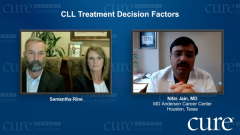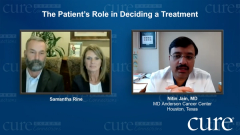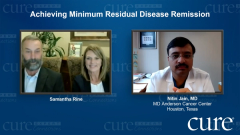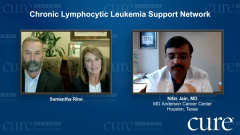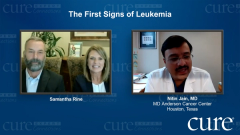
Chronic Lymphocytic Leukemia Diagnostic Process
Episodes in this series

Nitin Jain, MD: Samantha came to the MD Anderson Cancer Center with an abnormal white blood cell count on day one. Most of the time for CLL [chronic lymphocytic leukemia], patients present in a way where they have no symptoms, but it’s less common to have patients come to the ICU [intensive care unit], to the hospital, on day one of their CLL diagnosis. I think that was an extreme aspect of your case, where you had no prior history of cancers, leukemia, or any issues, and on day one, your blood cell counts were significant.
The blood cell counts were so abnormal that initially the suspicion from the doctors back home was that this could be acute leukemia, a different kind of leukemia. That’s why you were urgently sent to us and placed in the ICU because at the time of you coming in the ambulance, we thought we were dealing with an acute leukemia. Once you came here and we did some blood tests, it was clear that this was not an acute leukemia, and we finally diagnosed you with CLL.
Most patients with CLL will present without any symptoms. They go to their primary care physician, they perform a blood test, and the doctor will say, “Your white blood cell count is 30,000 or 15,000 lymphocytes/mm3 of blood,” which is higher than normal. The normal range is up to 10,000 lymphocytes/mm3. That is a common scenario where then patients will be referred to a hematologist/oncologist. They will do some blood tests, and that will confirm the diagnosis of CLL. Other times there are patients who develop some lymph nodes, such as swelling in the neck or in the armpits. Then they go to the doctor, the doctor evaluates it further, and these turn out to be lymph nodes of CLL.
Many patients in the early part of the disease have minimal to no symptoms, which also happened in your case. The only difference in your scenario was that your white blood cell counts were quite abnormal at the time of diagnosis. The CLL was probably brewing in your body for some weeks to months. It didn’t happen overnight. Because it was not giving you many symptoms, you were able to carry on with your life up until the event that led to your diagnosis. In terms of the investigation, I know you came to the hospital, we were in the ICU. Beside the blood tests, were there bone marrow, CT [computed tomography] scans, or other tests? What do you recall happening at that time?
Samantha Rine: We did a CT scan. The bone marrow and the CT scan were the biggest tests. You were checking the blood what seemed like every two hours.
Nitin Jain, MD: Early on when you came in, maybe in the evening, I don’t recall right now, our first suspicion was that this is something more worrisome, such as an acute leukemia. There was much more concern about that. By the next morning we had a somewhat clear indication, based on the blood tests, that this was not a case of acute leukemia, it is more like a chronic leukemia. It still needs to be treated, in your case right away, and that’s why we kept you in the ICU for a few days and then transitioned you up to the floor. That’s where we started to establish your diagnosis of CLL.
In terms of the diagnosis of CLL, typically we can diagnose patients on a blood test, and there’s a test called flow cytometry, which can be done in the blood and in the bone marrow. In Samantha’s case, we first checked the blood, but then we also performed a bone marrow test just to confirm. We were really worried about her blood cell counts, so we wanted to do a bone marrow test to have a more accurate assessment of her CLL. Many patients will also have CT scans done at the time of diagnosis to see how much lymph node tumor burden they have. Some of the lymph nodes we have in the neck, in our arm pits—the axilla—the doctors can feel on examination. But there are also lymph nodes we have inside our body, inside the chest, back of the chest, back of the abdomen. To assess them we need to do a CT scan, and that’s what we did for Samantha as well.
Many times for patients with CLL, as I said, the diagnosis can be established with the blood test. If a patient has early stage disease, and most of the patients in early stage disease don’t need to be treated, doing a bone marrow and a CT scan is not generally required. But in Samantha’s case, because there was a concern that we had to start treatment, her blood cell counts were abnormal, we ended up doing all those tests as well.
Transcript Edited for Clarity


